Gaza’s Missing Thousands: The Dead We Never Counted
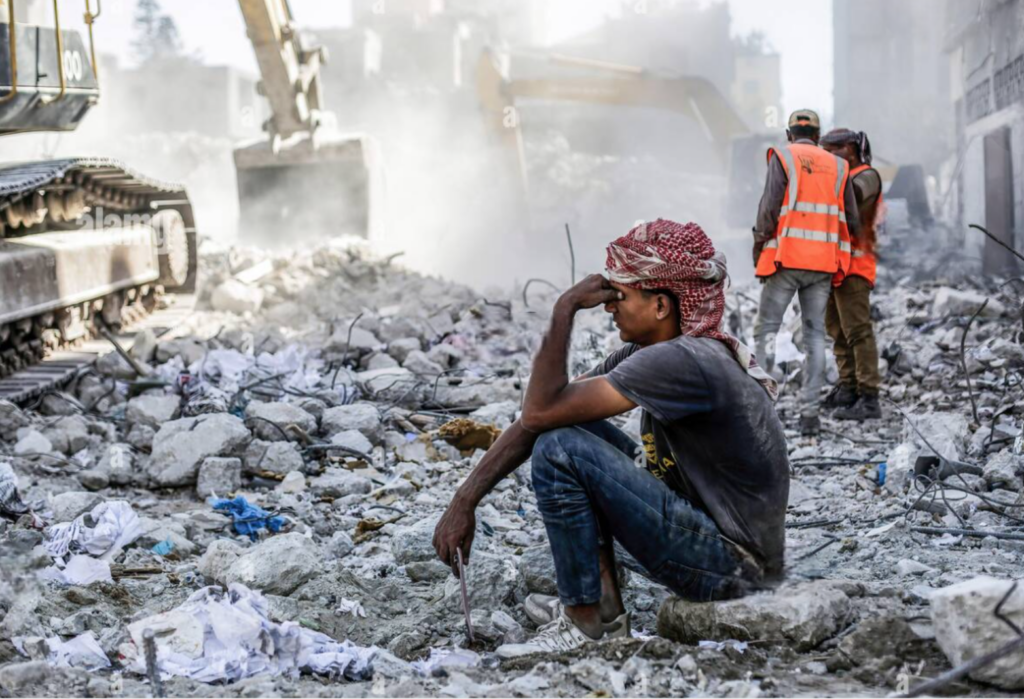
A recent study co-led by Irena Chen at the Max Planck Institute for Demographic Research (MPIDR) warns that the true human cost of the war in Gaza may be vastly undercounted. Using a Bayesian model that accounts for unreported deaths, missing demographic data, and measurement uncertainty, the researchers estimate that around 78,318 people (with a 95 % credible interval of 70,614–87,504) had died by the end of 2024, a figure much higher than widely publicized tallies.
The model also suggests that life expectancy in Gaza plunged from about 42.3 years in 2023 to roughly 40.4 in 2024, reflecting a staggering loss of 36 years in the counterfactual world without conflict.
Other independent studies echo these findings. A large-scale household survey, the Gaza Mortality Survey (GMS), concluded that at least 75,200 violent deaths occurred between October 2023 and January 2025, plus an estimated 8,540 non-violent “excess” deaths from starvation, disease, and the collapse of medical services together, bringing the combined toll to nearly 84,000 lives lost.
Meanwhile, a peer-reviewed study published in The Lancet compared hospital and morgue records from Gaza’s Ministry of Health with an online survey and social media obituaries, using a statistical “capture-recapture” method. It estimated 64,260 traumatic-injury deaths by June 30, 2024, about 41 % more than the 37,877 reported by the Ministry. That study also found that nearly 59 % of those killed were women, children or elderly people, among the most vulnerable, and often the least likely to be recorded.
That discrepancy, researchers warn, is only part of the story: neither the Max Planck analysis nor the Lancet study fully captures deaths caused indirectly by the war, from malnutrition, the breakdown of healthcare, or people trapped under rubble. In destroyed neighbourhoods, entire families may have perished with no one left to report them, and record-keeping systems have collapsed under bombardment. The Lancet authors note that these “indirect” deaths could be many times higher than the direct toll.
Taken together, the evidence paints a far grimmer picture than official numbers suggest. Countless civilian lives may never be documented, buried beneath rubble, erased from registries, and missing from the world’s tally. In Gaza, the war has silenced not only the living, but it has also erased the dead. Die Zeit has the story…
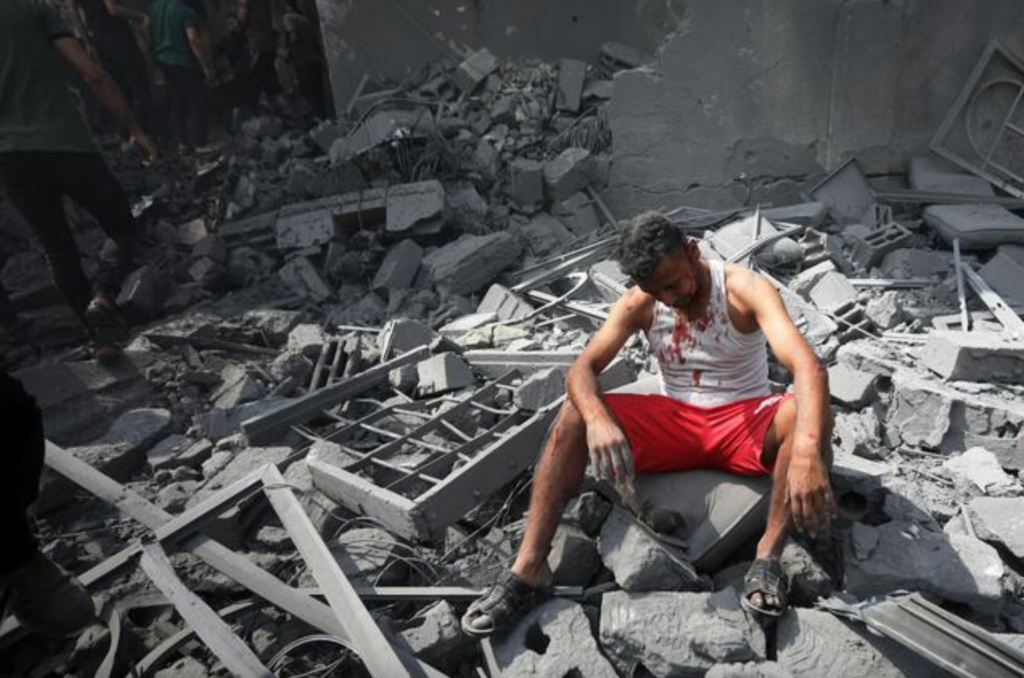
Christian Endt reports for Die Zeit…
More than 100,000 dead in the Gaza war
The number of Palestinian deaths in the Gaza war is hotly contested. ZEIT has obtained data suggesting that significantly more people may have died than officially reported.
The number of Palestinians killed in the Gaza war could be significantly higher than previously thought. According to calculations by a research team at the Max Planck Institute for Demographic Research in Rostock, at least 100,000 people have apparently died or been killed in the war, which has lasted more than two years. The research findings are available to ZEIT. “We will never know the exact number of dead,” says Irena Chen, co-leader of the project. “We are only trying to estimate as accurately as possible what a realistic order of magnitude might be.”
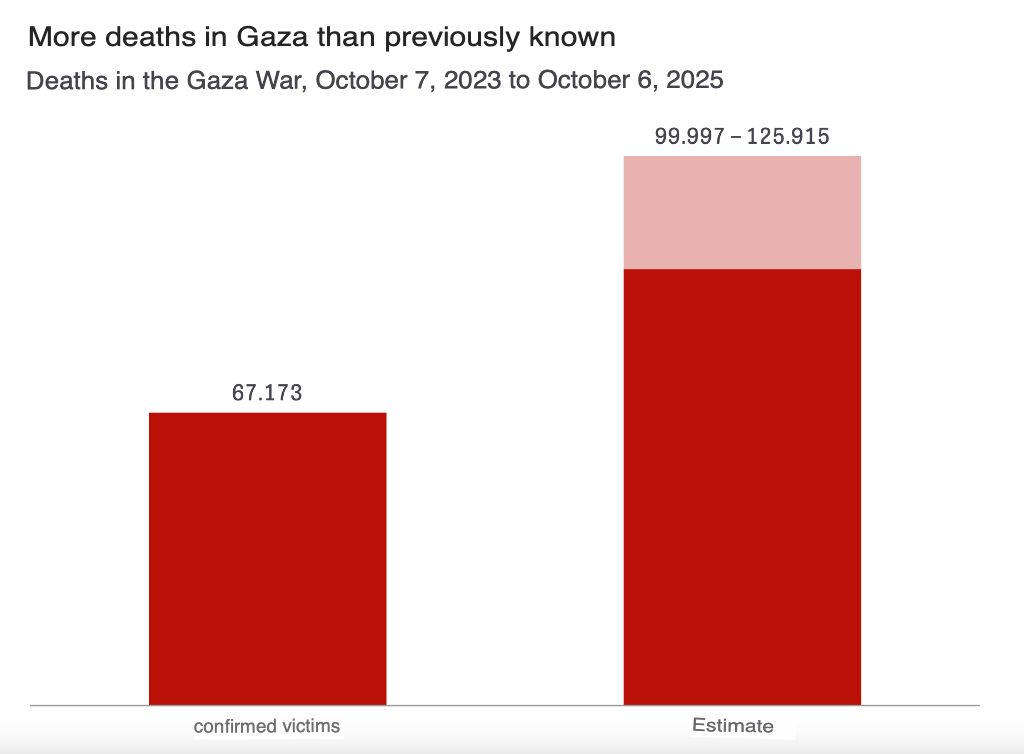
(Source: Gómez-Ugarte, Chen et al; OCHA; Gaza MoH)
The researchers from Rostock compiled data from various sources and performed a statistical projection. In addition to data from the Ministry of Health, they also incorporated an independent household survey and death reports from social media. The researchers published an article about their methodology in the journal Population Health Metrics in October. This article has been independently peer-reviewed by recognized experts.
Until now, the only official source for the death toll was the Gaza Strip’s Ministry of Health, which reported 67,173 fatalities in the first two years of the war . However, the ministry is run by Hamas, which is why its figures are questioned by the Israeli government and international observers. Even DIE ZEIT published the ministry’s figures with reservations.
However, there is no evidence of statistical manipulation. On the contrary, various research teams have previously determined that the Ministry of Health tends to be conservative in its counting. It is now well-documented that more people died in the war between Israel and Hamas than the official figures indicate. Different studies consistently arrive at a high number of unreported deaths.
The Ministry of Health only counts confirmed deaths , for example, those with a death certificate from a hospital. Since many hospitals had to cease normal operations during the war, the ministry now also uses death notifications from relatives; a panel then verifies the information. Victims buried under the rubble of bombed-out buildings, for instance, are often not recorded
A group of researchers from the London School of Hygiene and Tropical Medicine published an article in the medical journal The Lancet earlier this year . Zeina Jamaluddine and her colleagues compared several independently compiled lists of deceased individuals. Two of these lists came from the Gaza Strip’s Ministry of Health, while the third was based on obituaries posted on social media. The researchers found that many of the deceased appeared on only one or two lists. The degree of overlap allowed them to estimate how many of the deceased were not listed at all. According to their findings, the Ministry of Health’s underreporting could be around 41 percent.
A team led by Michael Spagat, a professor at Royal Holloway College, University of London, commissioned a survey around New Year’s Day 2025. Local staff from the Palestinian Center for Policy and Survey Research visited 2,000 households and inquired about the whereabouts of their members. The resulting number of potential deaths suggests a potential underreporting by the Ministry of Health of 35 percent. The researchers cannot rule out the possibility that some respondents fabricated deaths. On the other hand, the methodology does not capture households where all members have died.
The researchers in Rostock built upon previous findings and calculated detailed mortality estimates. Ana C. Gómez-Ugarte, Irena Chen, and their colleagues analyzed men and women, as well as different age groups, separately. This approach not only yields more precise overall figures but also allows for a detailed differentiation of who died. The accuracy of death recording varies depending on gender and age: women are counted less frequently than men. Deaths of those over 60 years of age are particularly often missing from official statistics.
In the first two years of the war, from the Hamas attack on Israel on October 7, 2023, to October 6 of this year, between 99,997 and 125,915 people died or were killed in the fighting in the Gaza Strip. The researchers’ median estimate is 112,069 people. In addition, 1,983 Israelis were killed, according to the Israeli Ministry of Defense. These figures only include those who died directly as a result of the fighting, in most cases, from Israeli airstrikes.
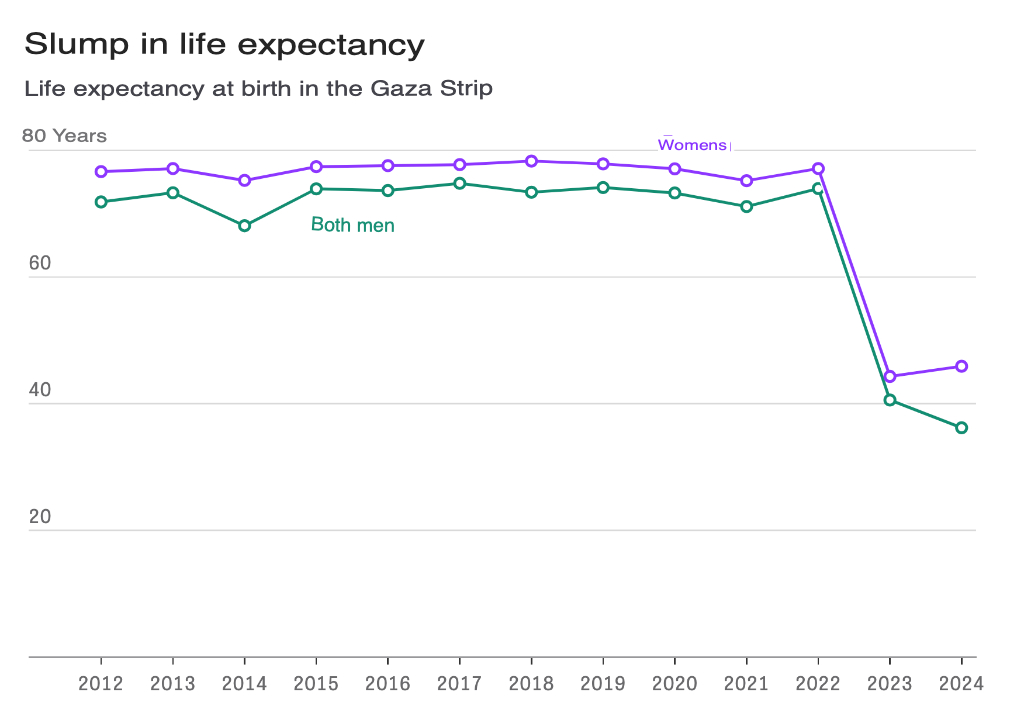
(Source: Gómez-Ugarte, Chen et al; PCBS)
Scientists at the Max Planck Institute in Rostock have also calculated the impact of the war on life expectancy in the Gaza Strip. Before the war, it was 77 years for women and 74 years for men. For 2024, the demographers project a figure of 46 years for women and 36 for men. This is initially just a statistical value. It indicates that if the fighting were to continue indefinitely as it has in recent years, Palestinians would only reach this average age. These figures illustrate just how dangerous life has become for the civilian population in the Gaza Strip.
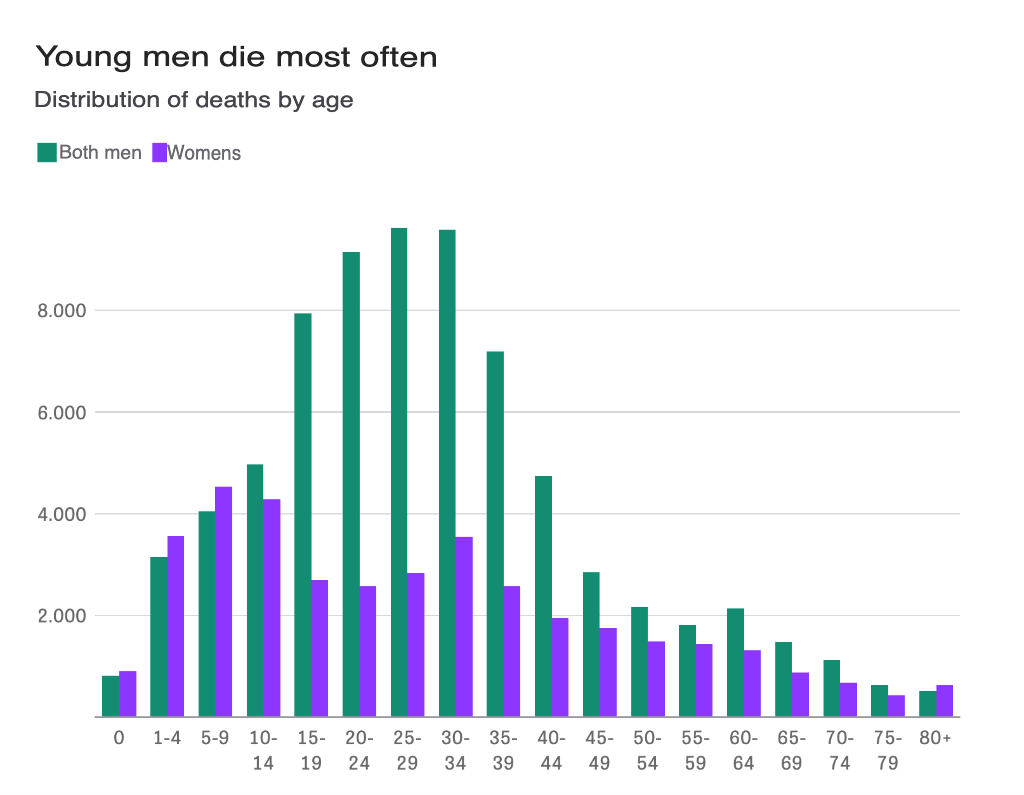
(Source: Gómez-Ugarte, Chen et al)
The scientists’ calculations show that approximately 27 percent of war dead are likely children under 15, and about 24 percent are women. According to the Max Planck researchers, the estimated distribution of deaths by age and gender corresponds to what the United Nations has observed in past genocides. In contrast, in fighting between armed groups, the deaths are much more concentrated among young men.
READ MORE PALESTINE NEWS AT: 21st CENTURY WIRE PALESTINE FILES
SUPPORT OUR INDEPENDENT MEDIA PLATFORM – BECOME A MEMBER @21WIRE.TV
VISIT OUR TELEGRAM CHANNEL
21st Century Wire is an alternative news agency designed to enlighten, inform and educate readers about world events which are not always covered in the mainstream media.
Source: https://21stcenturywire.com/2025/11/25/gazas-missing-thousands-the-dead-we-never-counted/
Anyone can join.
Anyone can contribute.
Anyone can become informed about their world.
"United We Stand" Click Here To Create Your Personal Citizen Journalist Account Today, Be Sure To Invite Your Friends.
Before It’s News® is a community of individuals who report on what’s going on around them, from all around the world. Anyone can join. Anyone can contribute. Anyone can become informed about their world. "United We Stand" Click Here To Create Your Personal Citizen Journalist Account Today, Be Sure To Invite Your Friends.
LION'S MANE PRODUCT
Try Our Lion’s Mane WHOLE MIND Nootropic Blend 60 Capsules
Mushrooms are having a moment. One fabulous fungus in particular, lion’s mane, may help improve memory, depression and anxiety symptoms. They are also an excellent source of nutrients that show promise as a therapy for dementia, and other neurodegenerative diseases. If you’re living with anxiety or depression, you may be curious about all the therapy options out there — including the natural ones.Our Lion’s Mane WHOLE MIND Nootropic Blend has been formulated to utilize the potency of Lion’s mane but also include the benefits of four other Highly Beneficial Mushrooms. Synergistically, they work together to Build your health through improving cognitive function and immunity regardless of your age. Our Nootropic not only improves your Cognitive Function and Activates your Immune System, but it benefits growth of Essential Gut Flora, further enhancing your Vitality.
Our Formula includes: Lion’s Mane Mushrooms which Increase Brain Power through nerve growth, lessen anxiety, reduce depression, and improve concentration. Its an excellent adaptogen, promotes sleep and improves immunity. Shiitake Mushrooms which Fight cancer cells and infectious disease, boost the immune system, promotes brain function, and serves as a source of B vitamins. Maitake Mushrooms which regulate blood sugar levels of diabetics, reduce hypertension and boosts the immune system. Reishi Mushrooms which Fight inflammation, liver disease, fatigue, tumor growth and cancer. They Improve skin disorders and soothes digestive problems, stomach ulcers and leaky gut syndrome. Chaga Mushrooms which have anti-aging effects, boost immune function, improve stamina and athletic performance, even act as a natural aphrodisiac, fighting diabetes and improving liver function. Try Our Lion’s Mane WHOLE MIND Nootropic Blend 60 Capsules Today. Be 100% Satisfied or Receive a Full Money Back Guarantee. Order Yours Today by Following This Link.






